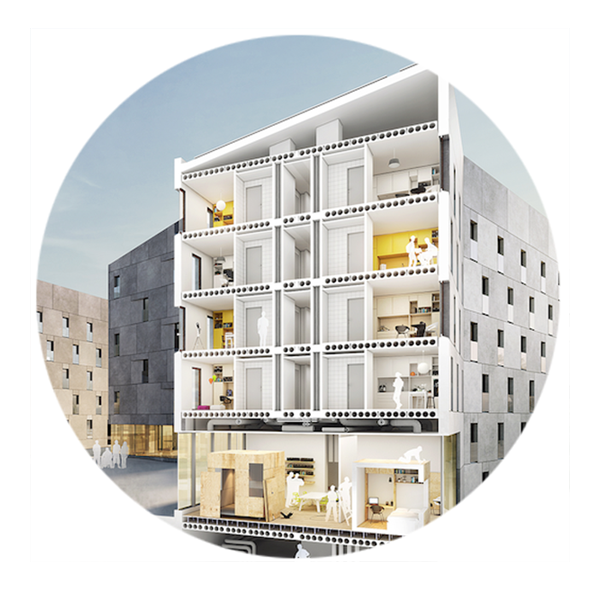An inflexible sector does not benefit from new technology
The public construction sector has the possibility to contribute to sustainable social development and thought-out integration of people, technology and the physical environment. But that potential risks being completely neglected if this sector is not also prepared to review its own core values. KTH Live In Lab's director, Jonas Anund Vogel, writes about the need for new perspectives.

Digitalisation and innovation related to, among other things, materials, products and methods make building systems more interconnected, which in turn makes our buildings and cities "smarter". With digital technology, more systems can be integrated, controlled and followed up, provided that they can be coordinated in a good way. Such integrated systems enable better use of resources, better data through monitoring, and better indoor comfort. In addition, new services are created for the actors who own, operate and manage the buildings. However, it has been shown that new technology that has been tested and verified in new test beds, including KTH Live-In Lab, does not reach its full potential once it has been implemented and installed. Technology alone does not solve all the challenges associated with the climate and resource use; in order to optimise buildings and reduce the building-related use of resources, competence and collaboration are also required.
The question then is why people with relevant knowledge should seek employment in the construction industry when they can apply for jobs at Google and Microsoft, the gaming industry or industries of the future, such as the pharmaceutical industry. What could make a well-educated newly graduated person see what many enthusiasts in the public construction industry argue for: the opportunity for social development and the integration of technology, people and the physical environment? How to change the image from crackling facades and trunk changes to instead be about transforming an entire industry; to cut the link between unsustainable use of resources and the use of buildings?
Well, how is it done? What happens when you invite the construction industry to dance? What happens when you lecture about the importance of common principles as a guarantor of success in complex construction projects? Or what happens when, as on 28 May, we invite to talks and presentations about the future educational needs for smart and sustainable buildings? Well, you dance alone, if not all alone – 23 people attended, of which six were presenters. This despite the fact that the invitation went out on KTH's website, via KTH Live In Lab's network, via Energi & Miljötekniska föreningen and via personal Linkedin accounts. When we invited to a discussion about ventilation and corona, over 7o people participated. Lifelong learning and development of skills should reasonably be of at least as much interest as ventilation.
Soft parameters such as learning, competence and basic values are clearly not high on the agenda, despite the fact that they pose crucial questions for how the construction industry should be able to handle challenges related to our physical environment, regarding everything from resource use and good indoor environment to mental health. The National Board of Housing, Building and Planning gives an indication of the potential of working with corporate culture, learning and competence. The cost linked to negligence and fraud in the construction industry is in the class of SEK 100 billion, annually. Try to calculate that amount by optimizing the ventilation or inserting low-flush toilet seats.
The construction industry may think that it can sit quietly in the boat. Traditional and long-lived property owners feel safe and calm, the properties are their guarantee of eternal returns. But who would have thought that Norstedts would be acquired by Storytel? Maybe it is the customer contact that is the future business model, and who has it? Spotify, HBO, energy providers and home alarms companies. The list is long, and customer contact with the property owner does not end up at the top. Nor do the traditional customer contacts in the construction industry result in direct added value for the customer. The one with the most knowledge has the upper hand, and if you compare different sectors, it does not look good for the construction sector, neither in the short nor long term.
The National Board of Housing, Building and Planning makes a good effort to shed light on cultural issues, despite the intricate situation of not touching anything other than its ”areas of interest”, and KTH and other higher education institutions work with issues of lifelong learning and increased collaboration between academia and industry. But it's not enough. Young people who have not chosen community building in particular do not choose to switch to community building, despite the urgent need for new perspectives, skills and areas of cooperation. The construction industry is at the bottom of all lists related to digitalization and innovation, and it will remain there as long as there is no plan for how the industry organises itself to absorb this knowledge. It is not enough to just buy new systems or gadgets. The technology is not enough, it requires multidisciplinary competence and flexible organisations to handle it.
As long as so-called ”champions” or enthusiasts exist in the construction industry, it is immature; ideas that are built into the organisations in other sectors and industries are handled by special departments in the construction industry. Without addressing questions about education, lifelong learning, competence and basic values, the construction industry remains calm with its feet fixed on the bottom of Riddarfjärden, looking upwards at the beautiful rays and the splendor stemming from other sectors' successes and development.
Text: Jonas Anund Vogel, Manager KTH Live-In Lab
